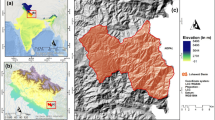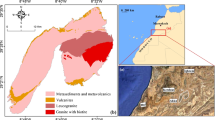Abstract
Soil erosion modeling in olive groves requires precise and accurate spatial data for the representation of topography associated with each time epoch considered. The precision and accuracy of altimetric values affect the quality of the digital elevation model (DEM) and therefore these requirements must be added to the necessity to generate high resolution DEMs. The increase of quality implies: 1. Improving the quality of the instrumentation and methodology applied in the field data collection and 2. Minimizing errors from the interpolation algorithm used to generate the digital terrain model. Currently, RTK networks are an indispensable complement to global navigation satellite systems (GNSS) precise positioning. The availability of highly accurate three-dimensional real time positioning has opened the door to new applications, making network-based real time kinematic (NRTK) positioning an attractive spatial data source for modeling soil erosion in small areas. This paper analyzes the quality of NRTK altimetric positioning supported by a local active network and its application in a test olive grove in SE Spain for soil erosion modeling. An evaluation procedure was implemented at several test sites distributed throughout an olive grove environment with special emphasis on filtering and checking the NRTK solutions in the vertical component. The precision in this component revealed a mean value of 15 mm and the vertical accuracy reached maximum values of 30 mm. In order to generate high resolution and accuracy DEM from the NRTK data, cross sections on the test olive grove were surveyed. The average altimetric quality value (CQ1D) of points surveyed was 0.017 m, according to the standard deviation estimated at test points. Based on the quality results, NRTK positioning is an accurate and reliable methodology for monitoring the erosion processes of small areas in an olive grove environment.







Similar content being viewed by others
References
Bakker, M. M., Govers, G., Jones, R. A., & Rounsevell, M. D. A. (2007). The effect of soil erosion on Europe’s crop yields. Ecosystems, 10, 1209–1219. https://doi.org/10.1007/s10021-007-9090-3.
Colomina, I., & Molina, P. (2014). Unmanned aerial systems for photogrammetry and remote sensing: A review. ISPRS Journal of Photogrammetry and Remote Sensing, 92, 79–97. https://doi.org/10.1016/j.isprsjprs.2014.02.013.
Dach, R., Hugentobler, U., Fridez, P., Meindl, M. (2007). Bernese GPS software version 5.0 user manual. Astronomical Institute, University of Bern, Switzerland, 612 pp. Retrieved from http://www.bernese.unibe.ch/docs50/DOCU50.pdf. Accessed July 5, 2018.
Dow, J. M., Neilan, R. E., & Gendt, G. (2005). The International GPS Service: celebrating the 10th anniversary and looking to the next decade. Advances in Space Research, 36(3), 320–326. https://doi.org/10.1016/j.asr.2005.05.125.
Edwards, S. J., Clarke, P. J., Penna, P. N., & Goebell, S. (2010). An examination of network RTK GPS services in Great Britain. Survey Review, 42(316), 107–121. https://doi.org/10.1179/003962610X12572516251529.
Euler, H.-J., Keenan, C. R., Zebhauser, B. E., & Wübbena, G. (2001). Study of a simplified approach in utilizing information from permanent reference station arrays. In Proceedings of ION GPS 2001 (pp. 379–391). Manassas, VA, USA: Institute of Navigation.
Euler, H. J., & Zebhauser, B. E. (2003). The use of standardized network RTK messages in rover applications for surveying. In Proceedings of the 2003 National Technical Meeting of the Institute of Navigation (pp. 377–384). Manassas, VA, USA: Institute of Navigation.
Farooque, A. A., Chang, Y. K., Zaman, Q. U., Groulx, D., Schumann, A. W., & Esau, T. J. (2013). Performance evaluation of multiple ground based sensors mounted on a commercial wild blueberry harvester to sense plant height, fruit yield and topographic features in real-time. Computers and Electronics in Agriculture, 91, 135–144. https://doi.org/10.1016/j.compag.2012.12.006.
Fountas, S., Aggelopoulou, K., Bouloulis, C., Nanos, G. D., Wulfsohn, D. Gemtos, et al. (2011). Site-specific management in an olive tree plantation. Precision Agriculture, 12, 179–195. https://doi.org/10.1007/s11119-010-9167-4.
Freeland, R. S., Buschermohle, M. J., Wilkerson, J. B., & Pierce, J. C. (2012). Precision agriculture-assessing virtual and single reference stations. Applied Engineering in Agriculture, 28(6), 913–922. https://doi.org/10.13031/2013.42466.
Garrido, M. S., de Lacy, M. C., & Rojas, A. M. (2018). Impact of tropospheric modelling on GNSS vertical precision: An empirical analysis based on a local active network. International Journal of Digital Earth, 11(9), 880–896. https://doi.org/10.1080/17538947.2017.1367040.
Garrido, M. S., Giménez, E., Ramos, M. I., & Gil, A. J. (2013). A high spatio-temporal methodology for monitoring dunes morphology based on precise GPS-NRTK profiles: Test-case of Dune of Mónsul on the south-east Spanish coastline. Aeolian Research, 8, 75–84. https://doi.org/10.1016/j.aeolia.2012.10.011.
Ghilani, C. D., & Wolf, P. R. (2010). Adjustment computations: Spatial data analysis. Hoboken, NJ, USA: Wiley. https://doi.org/10.1002/9780470586266.
Giménez, E., Garrido, M. S., De Lacy, M. C., & Gil, A. J. (2011). Comparing RTK positioning from updated REGAM and MERISTEMUM CORS networks in Southeast Spain. Journal of Applied Geodesy, 5, 23–35. https://doi.org/10.1515/jag.2011.003.
Gómez, J. A., Infante-Amate, J., de González Molina, M., Vanwalleghem, T., Taguas, E., & y Lorite, I. (2014). Review: Olive cultivation, its impact on soil erosion and its progression into yield impacts in Southern Spain in the past as a key to a future of increasing climate uncertainty. Agriculture, 4, 170–198. https://doi.org/10.3390/agriculture4020170.
Gumus, K., Selbesoglu, M. O., & Celik, C. T. (2016). Accuracy investigation of height obtained from Classical and Network RTK with ANOVA test. Measurement, 90, 135–143. https://doi.org/10.1016/j.measurement.2016.04.045.
Guo, Q., Li, W., Yu, H., & Alvarez, O. (2010). Effects of topographic variability and lidar sampling density on several DEM interpolation methods. Photogrammetric Engineering & Remote Sensing, 76(6), 701–712. https://doi.org/10.14358/PERS.76.6.701.
Hancock, G. R. (2005). The use of digital elevation models in the identification and characterization of catchments over different grid scales. Hydrological Processes, 19, 1727–1749. https://doi.org/10.1002/hyp.5632.
Harley, M. D., Turner, I. L., Short, A. D., & Ranasinghe, R. (2011). Assessment and integration of conventional, RTK-GPS and image-derived beach survey methods for daily to decadal coastal monitoring. Coastal Engineering, 58(7–8), 194–205. https://doi.org/10.1016/j.coastaleng.2010.09.006.
ISO. (2015). ISO 17123-8:2015—optics and optical instruments—field procedures for testing geodetic and surveying instruments—Part 8: GNSS field measurement systems in real-time kinematic (RTK). Geneva, Switzerland: ISO.
Janssen, V. (2009). A comparison of the VRS and MAC principles for network RTK. In Proceedings of IGNSS Symposium (pp. 1–13). NSW, Australia: IGNSS Society Inc.
Leica Geosystems. (2014). Leica viva series technical reference manual. Heerbrugg, Switzerland: Leica Geosystems AG.
Liu, H., Kiesel, J., Hörmann, G., & Fohrer, N. (2011). Effects of DEM horizontal resolution and methods on calculating the slope length factor in gently rolling landscapes. CATENA, 87, 368–375. https://doi.org/10.1016/j.catena.2011.07.003.
Lucieer, A., De Jong, S. M., & Turner, D. (2014). Mapping landslide displacements using Structure from Motion (SfM) and image correlation of multi-temporal UAV photography. Progress in Physical Geography, 38(1), 97–116. https://doi.org/10.1177/0309133313515293.
Lyard, L., Lefevre, L., Letellier, T., & Francis, O. (2006). Modelling the global ocean tides: Modern insights from FES2004. Ocean Dynamic, 56, 394–415. https://doi.org/10.1007/s10236-006-0086-x.
Niell, A. E. (1996). Global mapping functions for the atmosphere delay at radio wavelengths. Journal of Geophysical Research, 101(2), 3227–3246. https://doi.org/10.1029/95JB03048.
Ortiz, B. V., Balkcom, K. B., Duzy, L., Van Santen, E., & Hartzog, D. L. (2013). Evaluation of agronomic and economic benefits of using RTK-GPS-based auto-steer guidance systems for peanut digging operations. Precision Agriculture, 14, 357–375. https://doi.org/10.1007/s11119-012-9297-y.
Páez, R., Torrecillas, C., Barbero, I., & Berrocoso, M. (2017). Regional positioning services as economic and construction activity indicators: The case study of Andalusian Positioning Network (Southern Spain). Geocarto International, 32(1), 44–58. https://doi.org/10.1080/10106049.2015.1120358.
Pérez-Ruiz, M., Agüera, J., Gil, A. J., & Slaughter, D. C. (2011). Optimization of agrochemical application in olive groves based on positioning sensor. Precision Agriculture, 12, 564–575. https://doi.org/10.1007/s11119-010-9200-7.
Pérez-Ruiz, M., Gonzalez-de-Santos, P., Ribeiro, A., Fernandez-Quintanilla, C., Peruzzi, A., & Vieri, M. (2015). Highlights and preliminary results for autonomous crop protection. Computers and Electronics in Agriculture, 110, 150–161. https://doi.org/10.1016/j.compag.2014.11.010.
Ramos, M. I., Feito, F. R., Gil, A. J., & Cubillas, J. J. (2008). A study of spatial variability of soil loss with high resolution DEMs: a case study of a sloping olive orchard in southern Spain. Geoderma, 148, 1–12. https://doi.org/10.1016/j.geoderma.2008.08.015.
Ramos, M. I., García, A. L., Garrido, M. S., Feito, F. R., & Gil, A. J. (2011). Control of real time GPS data to analyze the erosion in an olive farm. In N. Mastorakis, V. Mladenov, C. M. Travieso-Gonzalez, & M. Kohler (Eds.), Proceeding of the 2nd European Conference of Control ECC ′11, Recent Researches in Engineering and Automatic Control (pp. 19–23). WSEAS Press.
Spanish Ministry of Agriculture, Food and Environment. (2013). Survey on Cultivation Areas and Crop Yields in Spain, ESYRCE (in Spanish).
Takac, F., & Zelzer, O. (2008). The relationship between network RTK solutions MAC, VRS, PRS, FKP and i-MAX. In Proceedings of ION GNSS 2008 (pp. 348–355). Manassas, VA, USA: Institute of Navigation.
Wanninger, L. (2008). Introduction to Network RTK. IAG Working Group 4.5.1: Network RTK (2003–2007). Retrieved from (http://www.wasoft.de/e/iagwg451/intro/introduction.html). Accessed July 5, 2018.
Acknowledgements
Support provided by the Institute of Statistics and Cartography of Andalusia (RAP network) during this project is gratefully acknowledged. The authors thank the Editor and two anonymous reviewers for their valuable comments and recommendations, which contributed to the improvement of this paper. This work was funded by the University of Jaén and “Caja Rural Jaén” (UJA2015/06/11 Project), RNM282-Microgeodesia Jaén Research Group (Junta de Andalucía) and PAI UJA 2017/18.
Author information
Authors and Affiliations
Corresponding author
Rights and permissions
About this article
Cite this article
Garrido, M.S., de Lacy, M.C., Ramos, M.I. et al. Assessing the accuracy of NRTK altimetric positioning for precision agriculture: test results in an olive grove environment in Southeast Spain. Precision Agric 20, 461–476 (2019). https://doi.org/10.1007/s11119-018-9591-4
Published:
Issue Date:
DOI: https://doi.org/10.1007/s11119-018-9591-4




